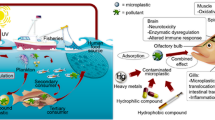Abstract
The equilibrium partitioning theory may be used to describe the partitioning of nonionic organic chemicals between water, sediment, and aquatic biota. This paradigm was employed to compare the relative magnitudes of organic carbon-normalized sediment-quality criteria that are intended to protect either benthic organisms from the direct toxic effects of sediment-associated chemicals or humans from the indirect health effects posed by the ingestion of contaminated aquatic animals. Comparison of calculated sediment-quality criteria for a variety of hydrophobic chemicals suggests that human health-based end points often result in more restrictive criteria than aquatic effects-based values. Review of published field data indicates that the equilibrium partitioning paradigm may, depending on contaminant class, either over- or underestimate the extent to which sediment-associated contaminations are bioaccumulated. Despite the limitations of adopting this simple theory for criteria development, calculations reveal that regulatory decisions involving sediments contaminated with such chemicals may be dictated by human health concerns if current risk assessment methodologies are applied.
Similar content being viewed by others
Rights and permissions
About this article
Cite this article
Parkerton, T.F., Connolly, J.P., Thomann, R.V. et al. Do aquatic effects or human health end points govern the development of sediment-quality criteria for nonionic organic chemicals ?. Environ. Sci. & Pollut. Res. 4, 193 (1997). https://doi.org/10.1007/BF02986343
Issue Date:
DOI: https://doi.org/10.1007/BF02986343




